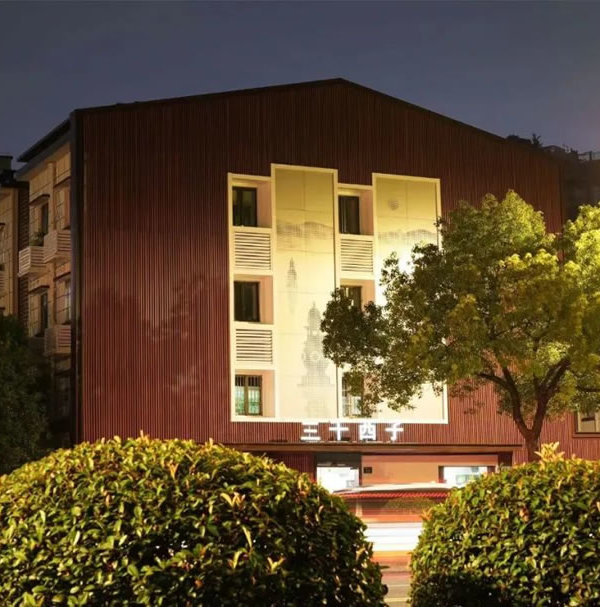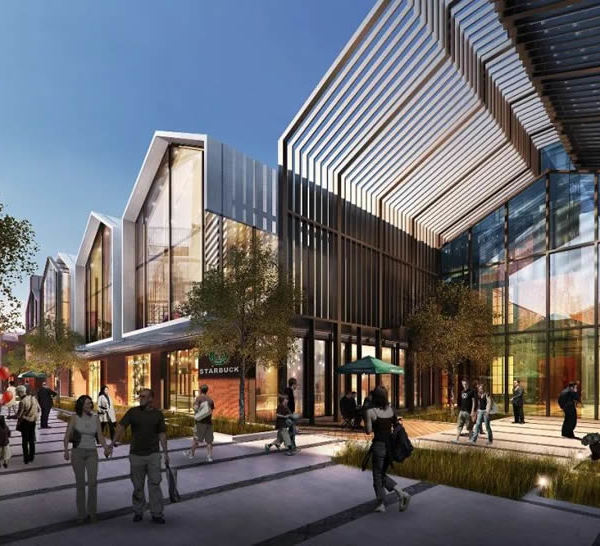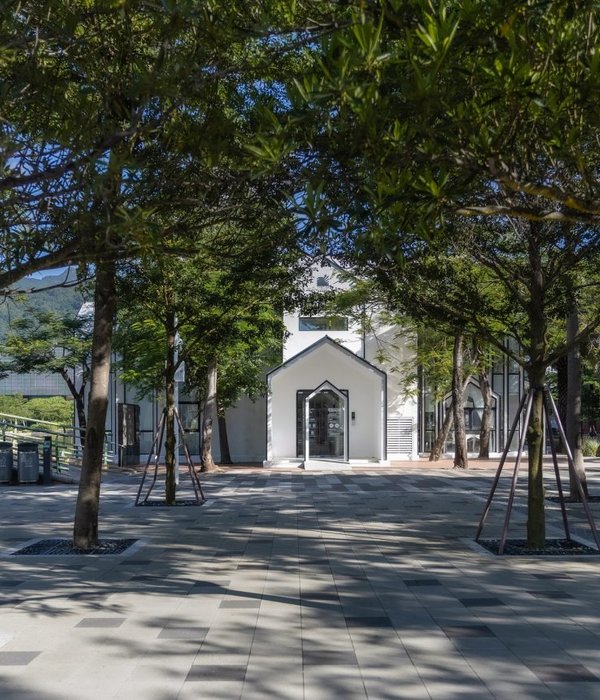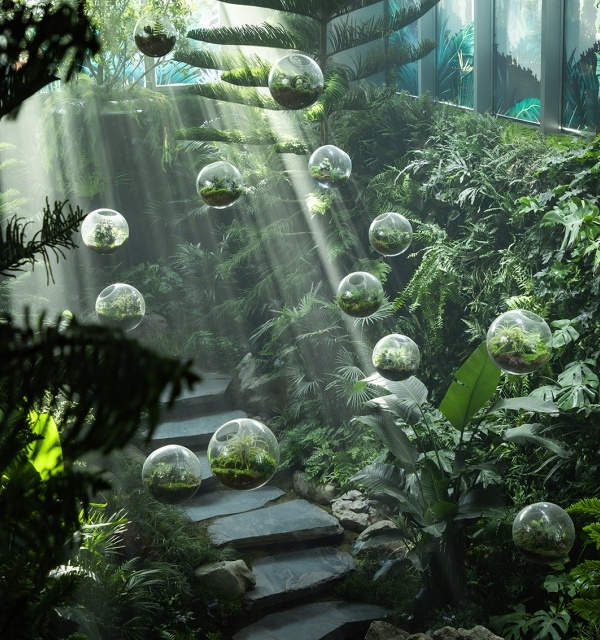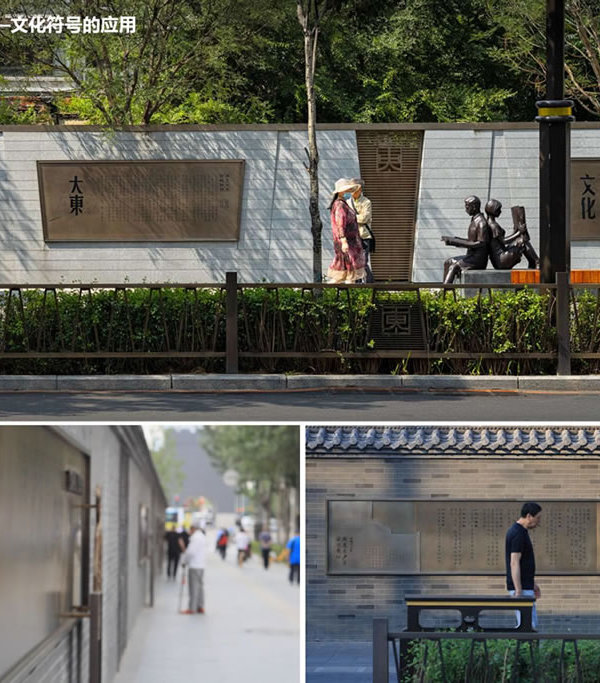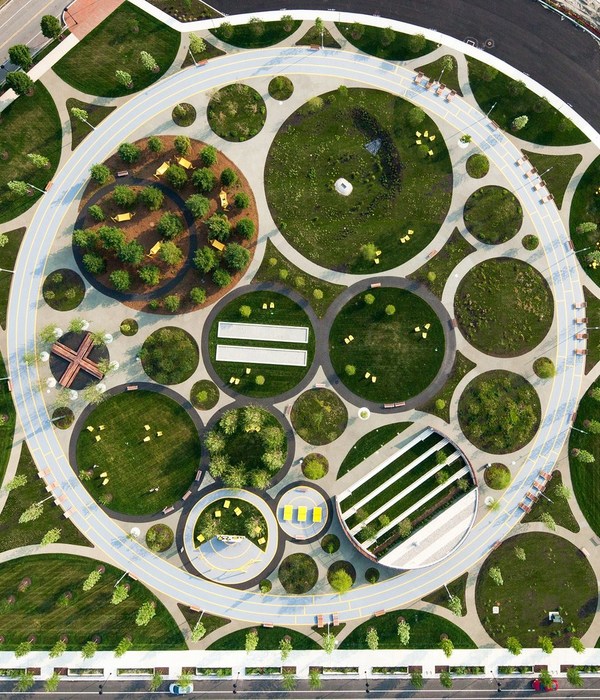街子古镇梅驿广场与青鸾公园 | 山水画卷中的公共空间
- 项目名称:街子古镇梅驿广场和青鸾公园
- 设计单位:北京华清安地建筑设计有限公司成都分公司
- 主创建筑师:蒲建聿
- 设计团队:刘伯英,蒲兵,吴沙沙
- 地点:崇州市街子镇
- 设计时间:2013~2014年
- 竣工时间:2014~2016年
- 基地面积:170亩
- 建筑面积:1.2万平米
- 结构形式:钢结构,钢筋混凝土框架结构
梅驿广场,是街子古镇十里山水长卷的图画中心。倚山、临河,与古镇的长街炊香隔岸相望。是经由味江河、凤栖山进入古镇的新路径规划入口和游客中心——见山水而见街子。从青鸾公园到梅驿广场,期望通过由景观语序、空间意向和视觉印象的组织,澄怀观道。传咏着人与环境、故事与诗词,而思接千载,神合意会。
Meiyi Square, center of the extensive natural landscape of Jiezi Ancient Town, near the hills and rivers, faces the main street of the ancient town. It is the planned entrance and tourist center of the ancient town along Weijiang River and Mount Fengqi. From Qingluan Park to Meiyi Square, it is expected to appreciate the scenery through the organization of landscape order, spatial intention and visual impression, which manifests the people and environment, stories and poem thus filling people’s minds with a myriad of thoughts.
▼梅驿广场全景,overview of Meiyi Square

建筑设计以古镇传统民居形式为意向,以山、水、古镇的相邻关系和新城区的城市设计为尺度和背景。建筑以山水为宗,以内观的空间自制力和形式语言的简净,寻求谦和虚澹,与环境气象相和。设计结合当地的建筑外廊形式为立面构成,以碳化原竹和耐候竹型材进行围护,并在金属屋面的肋上附着原竹构成。使之呈现时间与气候的沉着,和光同尘。或添空山新雨的画境质地。竹,作为本地区最日常的景观和生产、生活要素,以质朴的材料气质和肌理,体现在建筑的主题中。将建筑体量消隐、弱化,获得建筑群的整体理性、简洁与中和。在与环境的统一之中尝试古典意境的表达。通过真实材质的自然表现,使建筑色彩与环境相和,相映与相应。“用墨无他,惟在洁净。”
The architectural design features the forms of the traditional residence of the ancient town with the neighboring relations of the mountains, water and ancient village as well as urban design of the new urban area as the scale and background. Themed with the natural landscape, the architecture intends to seek modesty with inner space self-control and purity of formal language which is consistent with the meteorology. The design combines the features of local architecture contour as the façade, enclosed by carbonized original bamboo and anti-weathering bamboo materials and composed of the metal roof ribs with original bamboo attached, showing the composure of time and climate, standing aloof from worldly success. Bamboo, as everyday landscape and elements of local life and production with rustic quality and texture, is reflected in the theme of the building. The construction volume is blanked and weakened to obtain overall rationality, concision and neutrality of the architectural complex, thus classical mood is conveyed in unity with the environment. The architectural color conforms to the environment harmoniously by means of natural performance of undecorated materials.
▼梅驿广场断桥入口,Broken Bridge entrance
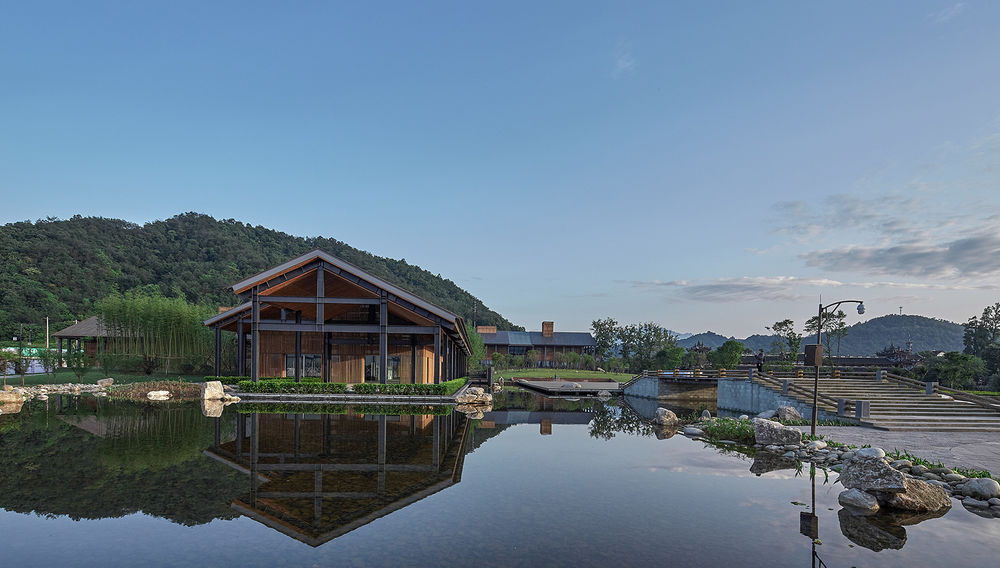
▼梅驿广场侧影,reflection in water
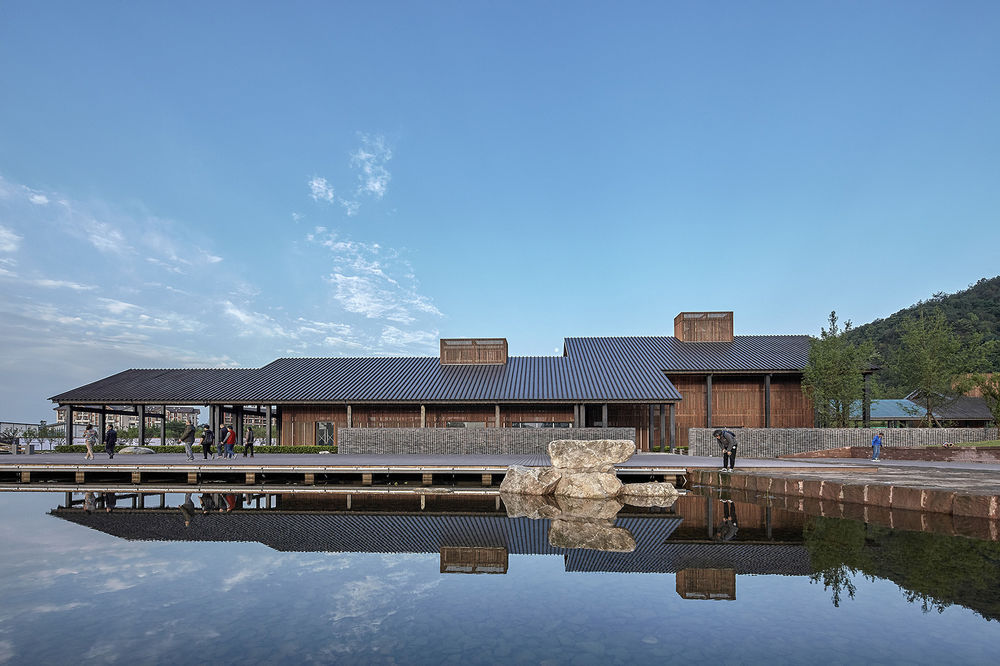
根据场地地形和建筑剖面关系,设计将土方的开挖结合景观元丘的堆土进行了平衡。环廊和深出檐提高场所的气候适应性。竖向的原竹排列,在建筑立面形成遮阳和屏围。在表层原竹与幕墙之间形成结构、机电构造和空气流动的空腔,并通过内置、嵌入的天井和高出屋面的天窗形成夏季室内外的气流组织。
The design means to balance the excavation of earthwork and the mounds of the landscape<YuanQiu> according to the relationship of site topography and cross-section of the buildings. And the ring corridor and deep eaves could improve the climate adaptability of the site. Vertical arrangement of original bamboo makes it possible to form the shade on the façade. Structure, mechanical construction and air flow cavity shaped between the surface original bamboo and curtain walls, together with built-in and embedded patio and the skylight above the roof, formed both indoor and outdoor air distribution system in the summer.
▼梅驿广场西入口柱廊,corridor of the west entrance
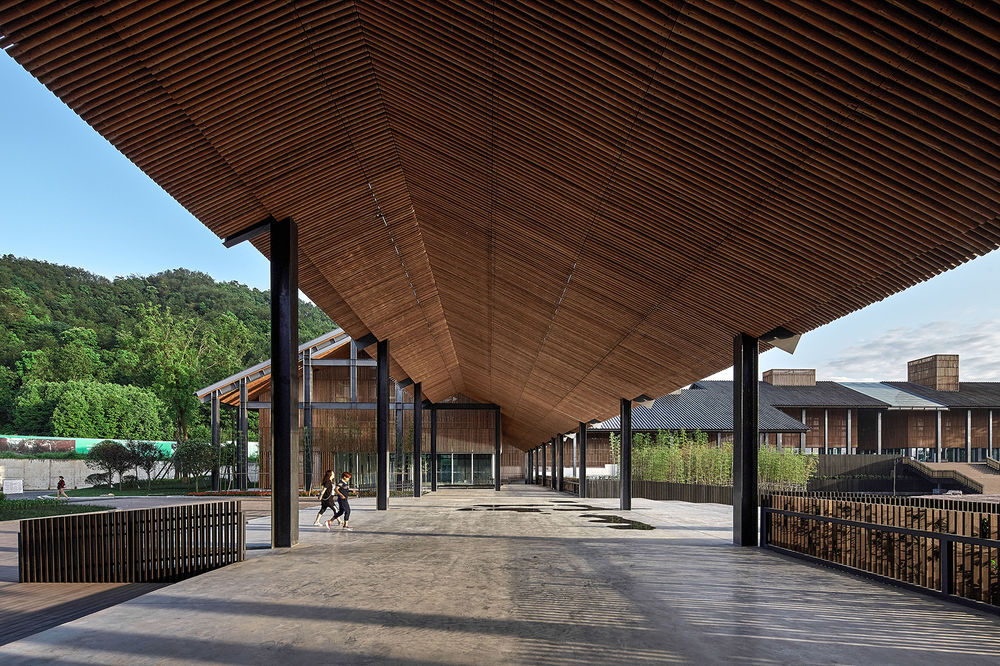
▼广场内庭,inner courtyard
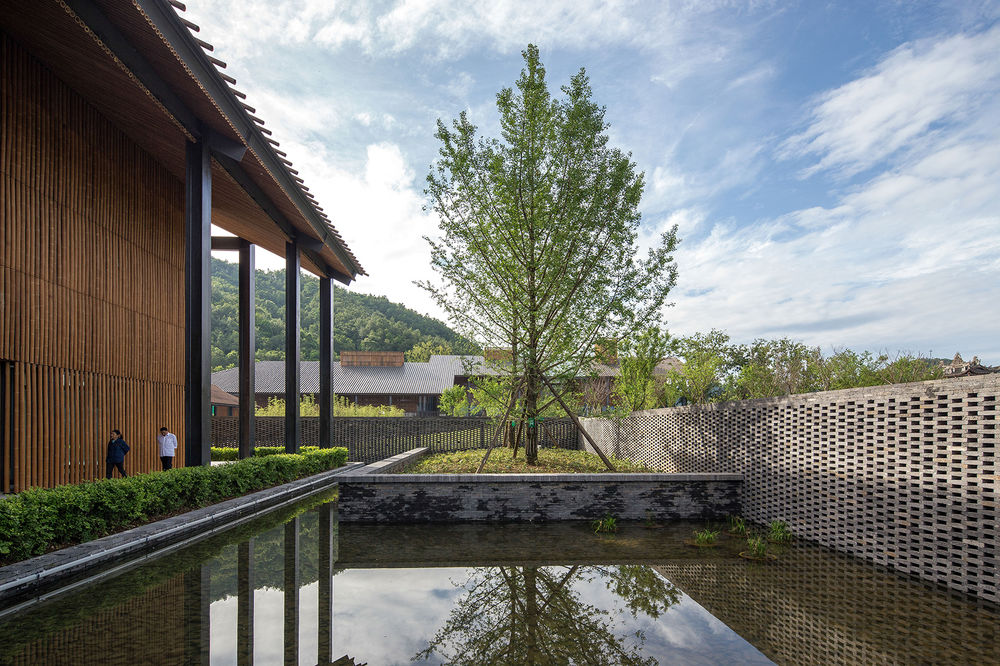
▼游客中心,visitor centre
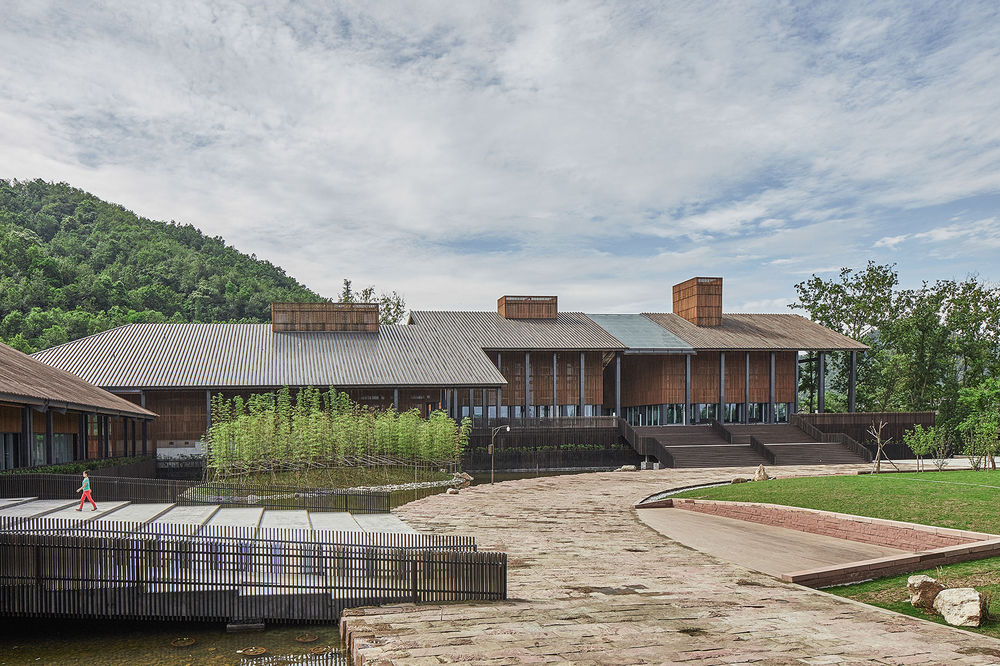
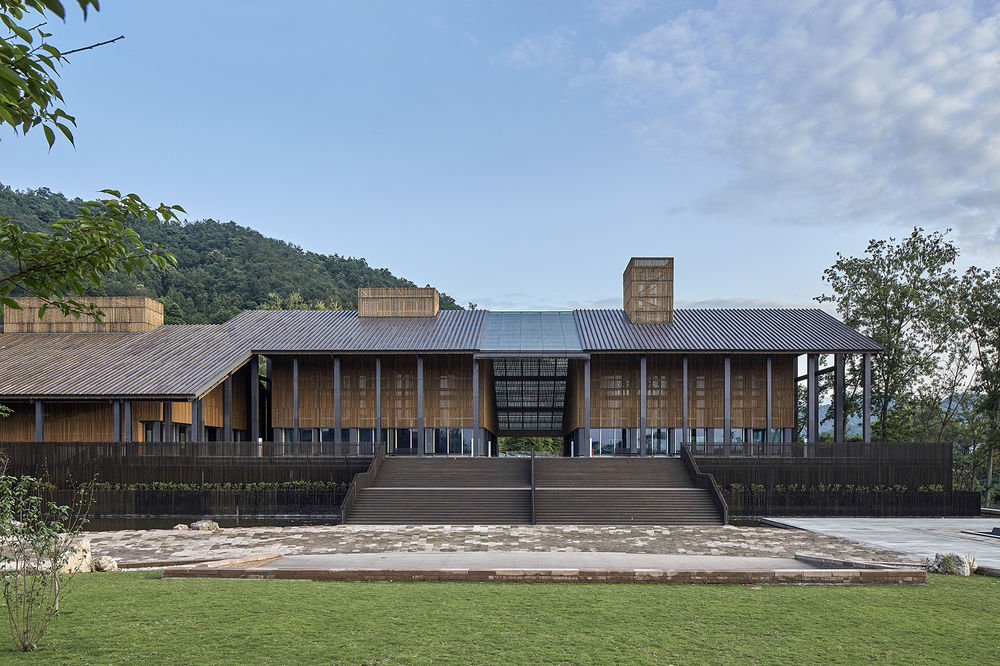
▼游客中心平台,visitor centre platform
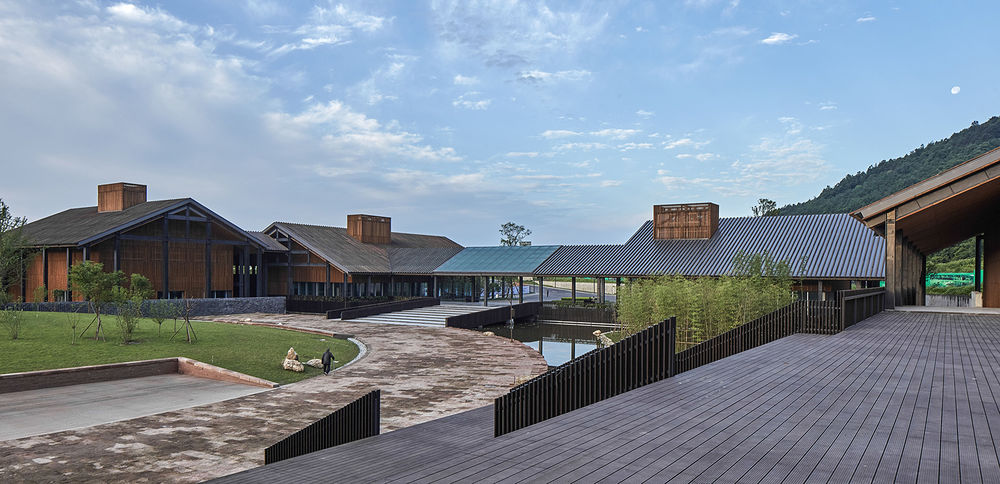
▼建筑细部,detailed view
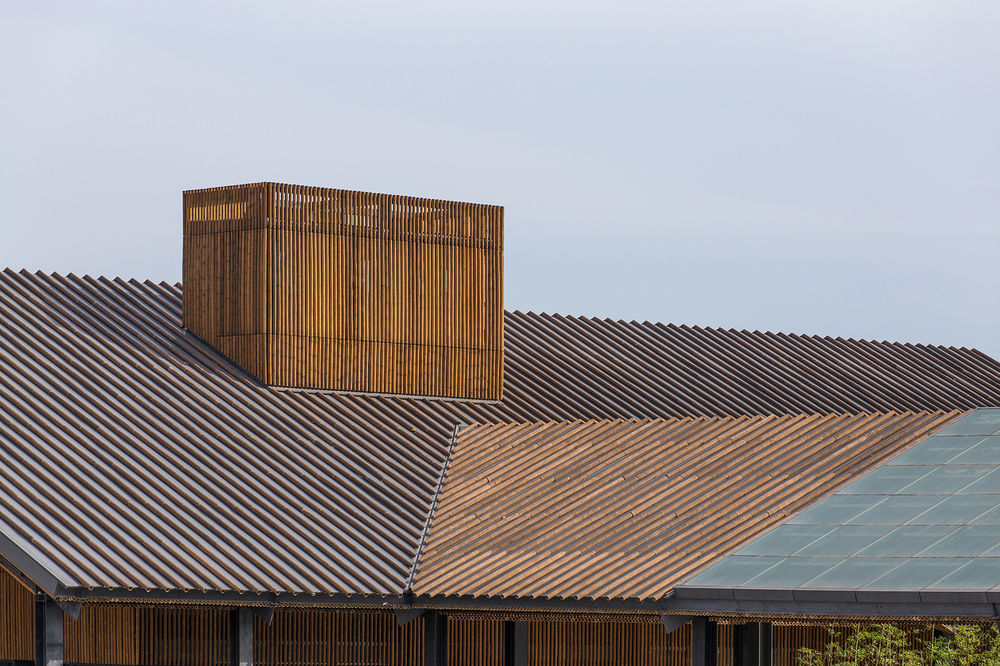
景观设计接合青鸾公园北端,以水面、元丘和梅林,将场所的人文情怀清静内敛。从环山渠引入场地的水体环绕并倒映建筑,在夏季形成清凉的环境。沉着痛快,灿然成象。
The landscape design, connecting the north end of Qingluan Park and including water surface, hillock and plums, quiet and introverted, creates a perfect place to enjoy the cool air in summer with water introduced from the drainage circling and reflecting the architecture. Calm and delightful.
▼游客中心檐下肌理,texture under the roof
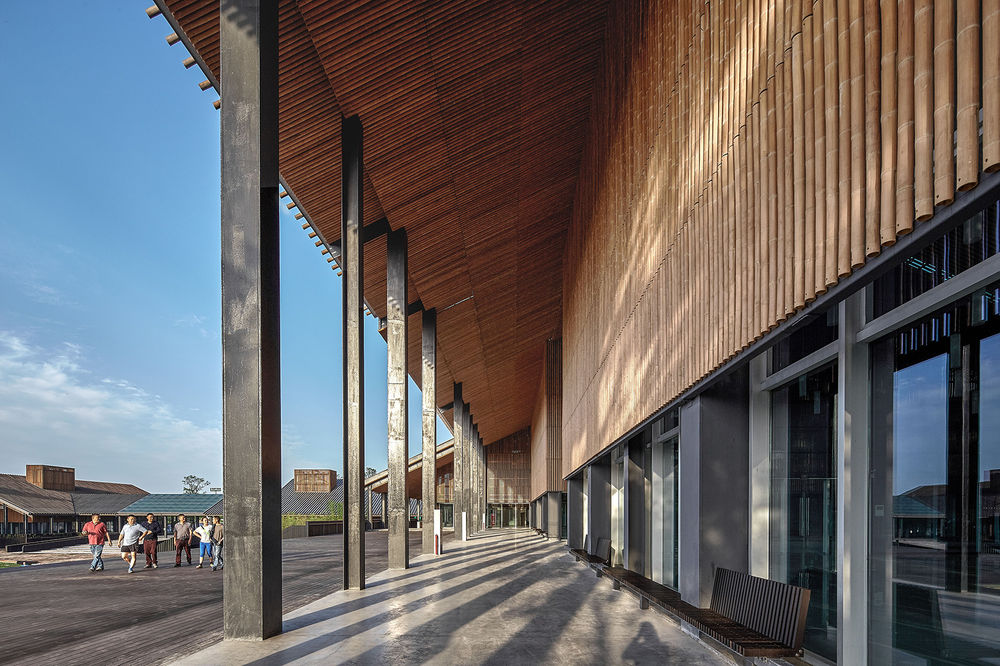
▼廊道,corridor

▼游客中心室内,interior of the visitor centre
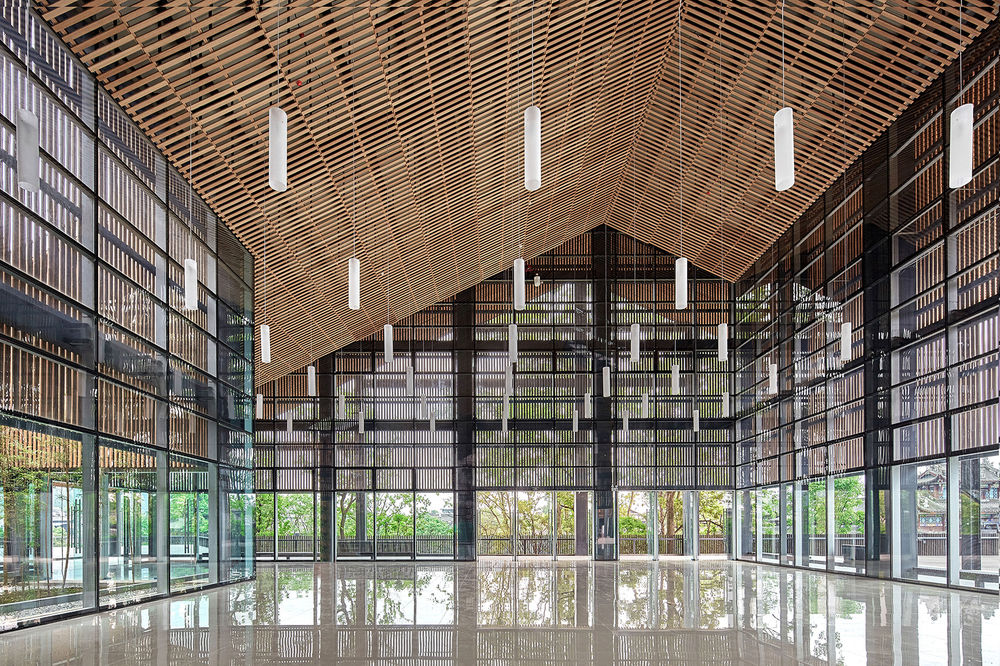
青鸾公园是游客滨河而行的重要路径。场地规划突出山水特点,不单是美学上的策略,还紧扣旅游和当地未来的经济文化活动,带来健康与活力。作为小镇空间外延的休闲场地、自然栖息地,形成人们游览、闲聚、休憩等的一块包容多种活动的公共绿毯。
Qingluan Park is an important path for the tourists to walk along the river. Emphasizing the natural landscape, the site planning not only takes advantage of aesthetic strategy, but also closely linked to tourism and local economic and cultural activities in the future, bringing health and vitality. As an extended leisure venue and natural habitat of the town, it will become a public green carpet inclusive of sightseeing, gathering, leisure, etc.
▼青鸾公园步道,
footpath in
Qingluan Park

延续古镇的人文气质,总图契合古典诗文“起、承、转、合”的结构和节奏,摹拟叙事和情绪铺陈,让游观过程成为一次意境悠远的体验。广场、路线和节点的设置,与行进、游观时山、水的视线和场景感受相关。游观路径非常丰富,穿越一系列对比型的空间:高大的树林和开敞的草坪、平静的水面,低洼和浅丘。跟随鸾舞道亲水栈道,在河畔、梯田间起伏、迂回,联想青鸾飞掠的恣意。草苇间,河水带来的泥沙沉淀形成天然沙滩,可成为水鸟的栖息地。拾级而上,到达鸾舞台。在这里,覆土建筑退台扩大形成临河的露天绿茵剧场。这一大尺度的公共空间,可以作为游人的浪漫聚会、休憩、游戏、运动以及举办文化活动的观演场所。在山水间,天地同台。
Continuing the human temperament of this ancient town, the general plan fits the structure and rhythm of “introduction, elucidation, transition and summing up” of classical poems perfectly, simulating narrative and emotional elaboration, making touring an experience with artistic conception. The setting of the square, route and nodes are related to sight and scene feelings of the natural landscape when traveling. The traveling routes are various, passing through a series of comparative space, including tall tress, open lawn, calm water, low-lying land and shallow hills. Following the waterside path, fluctuating between the river and the terraces, the tourists will associate the unscrupulous Argusianus argus flying through the water surface. Among the straw reed, natural beach is developed owing to the deposition of the sand brought by the river, which can be a waterfowl habitat. Climbing the stairs, the tourist will reach Luan stage. Here, an open green theatre is formed by the river through the expansion of the earth-sheltered architecture, so the large-scale public space can be a place for romantic gathering, leisure, games, sports as well as holding cultural activities. The heaven and the earth integrate harmoniously among the landscape.
▼秋草砌,lawn
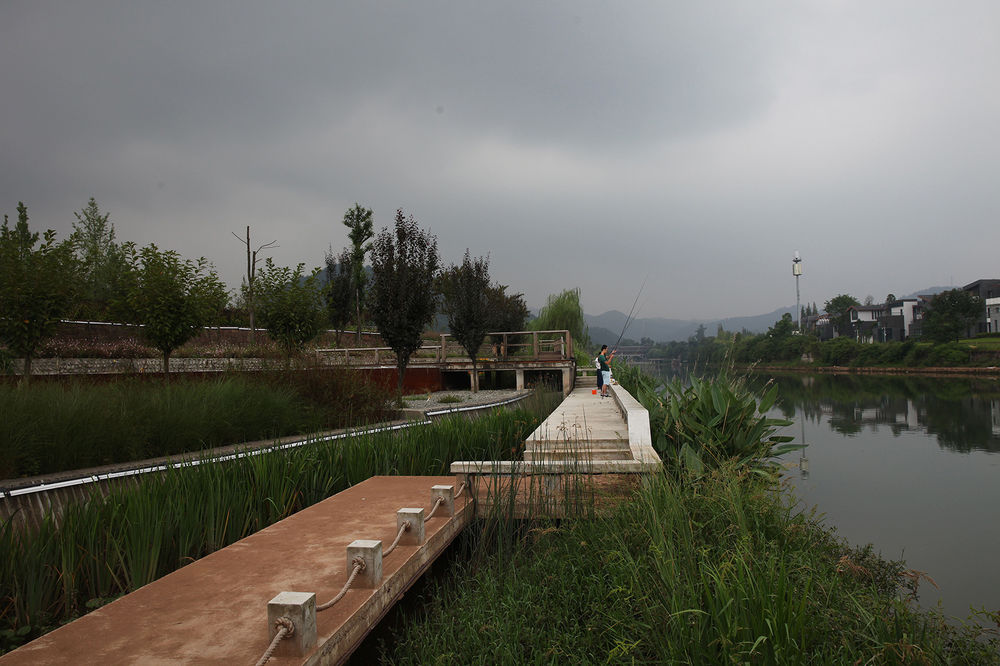
贯穿整个园区的台地景观是青鸾公园的重要特色。采用层层退台方案,加大渗透性地面面积,形成植物栖息地。采取多重、跌级式驳岸处理,改善岸线的景观界面,形成自然河岸和良好的湿地、滨水空间。创建微地形,邀请洪水进入场地恢复湿地环境,引发自然演替。
Terraced landscape throughout the park is an important feature of Qingluan Park. The terrace-backwards layer program is adopted to increase the permeable ground area and form a plant habitat. It also employs multiple rebating revetment treatment to improve the shoreline landscape interface and develop a natural bank and good wetland and waterfront space. Micro-topography is created and flood is allowed to enter the venue to restore wetlands to stimulate natural succession.
▼舞台沙洲,stage sandbar

植物设计结合带状的梯田形成多层次的景观。坚持本土性、低成本原则。大部分植物皆为多年生草本,可粗放管理,自然露地越冬。尽可能降低后期维护成本。同时,植物与建筑、景观的配合,制造故事场景和文化氛围。
The plant design presents a multi-level landscape combining the ribbon-shaped terrace. It follows the principle of being local and cost-effective. Most plants are perennial herbs that can be managed extensively and overwintering in the field. And the cost of later maintenance is minimized to the largest extent. Simultaneously, the coordination of the plants and architecture, landscape produces story scene and cultural atmosphere.
▼青鸾公园绿岛,green island

最后,游线合于梅驿广场中心的元丘,达到景观主题的高潮。
Finally, the touring paths intersect in the hillock in the center of Meiyi Square, achieving the climax of landscape theme.
▼梅驿广场元丘与凤栖山,hillock and Fengqi Mountain
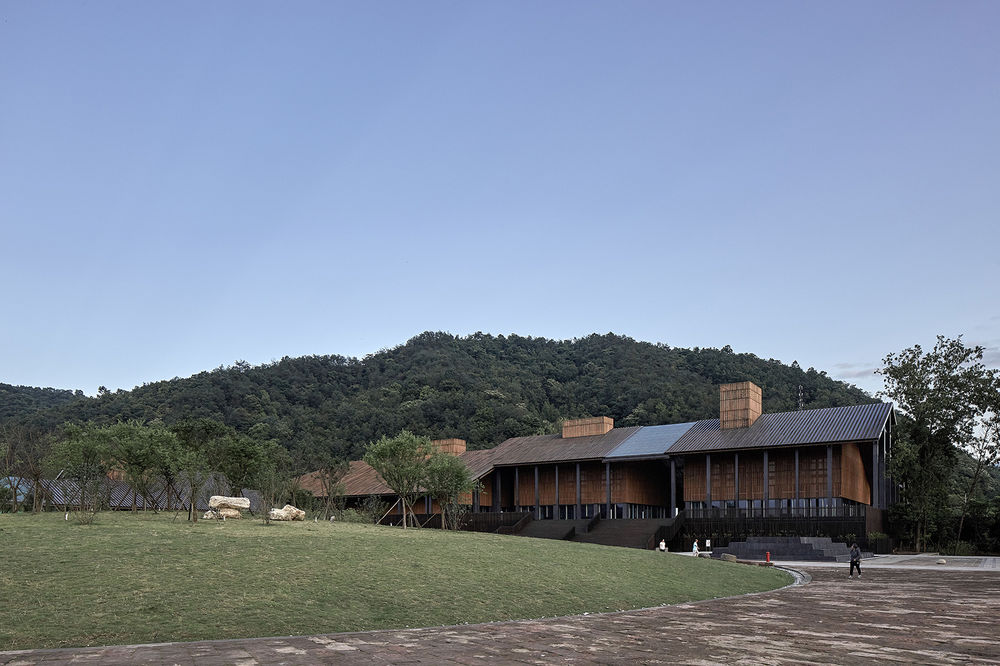
实施过程 | Process of Implementation
历时两年的实施过程,跟进了大量的现场作业。努力在平衡和协调设计管理、施工建设、材料与构造等相关问题的过程中,在青城“道”的场所精神下,得到一个克柔并顺应矛盾关系的结果:形–以公园路径和水岸的灵动,与游客中心建筑和山体的沉静相对应,表现阴阳相衡的形态;意–以景观呈现的季节变化和时间流转,对应场所的空间凝固,表现天圆地方的时空意向;境–以山水图画之中人的活动和情景体验,表达自然之道的境悟。
The implementation process lasts two years and follows a lot of field operations. It strives to obtain a result which conforming the contradiction relations in the process of balancing and coordinating design management, construction, materials and structure and other related issues with the spirit of “Taoism”. Form—the smartness of the routes and waterfront, corresponding to the stillness of the architecture of the tourist center and mountain , manifests the balance of Yin and Yang; Intention—the seasonal change and time circulation presented through landscape paralleling with the site spatial solidification shows the intention of round heaven and square earth; Realm—human activity and sight experience in the picture embodies the realm of nature.
▼广场模型,model of the square
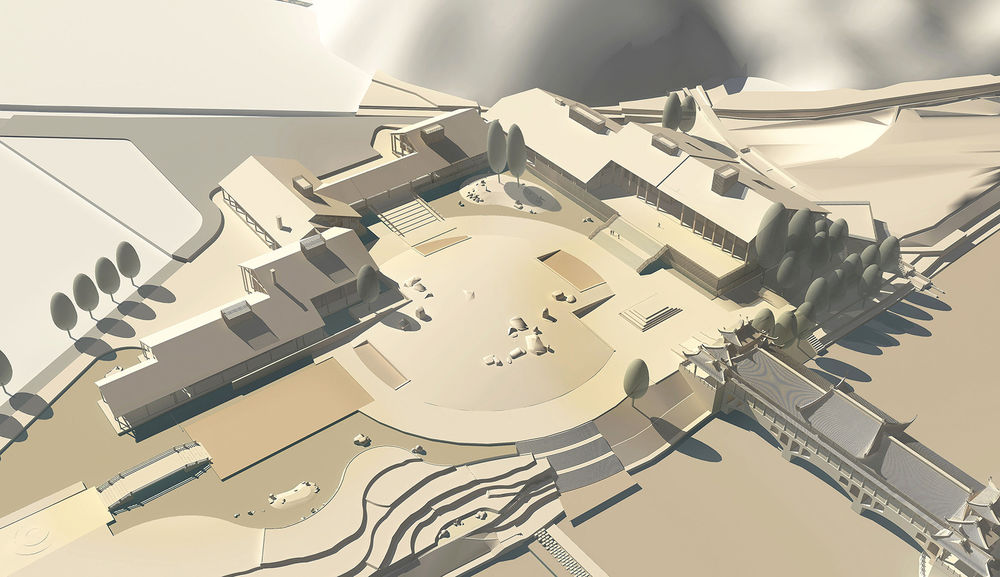
最后这点,也是方案中待实施的塔的位置和意义所在。观复塔,是场地内景观制高点和建筑标志物。以登高望远的视野,展现山水长卷的画境。自然道理,静默呈现。——《道德经》十六卷曰:“致虚极,守静笃。万物并作,吾以观其复。”
The last point is the location and significance of the tower to be carried out in the program. Guanfu Tower is the highest point of landscape and architectural marker in the site. The enormous landscape is clearly shown with higher vision. The natural reason is rendered silently.—“Tao Te Ching” Volume 16 wrote “Everything in the world is empty and quiet originally, thus to seek the essence, it must be restored to the original state of emptiness.”
▼总平面图,master plan
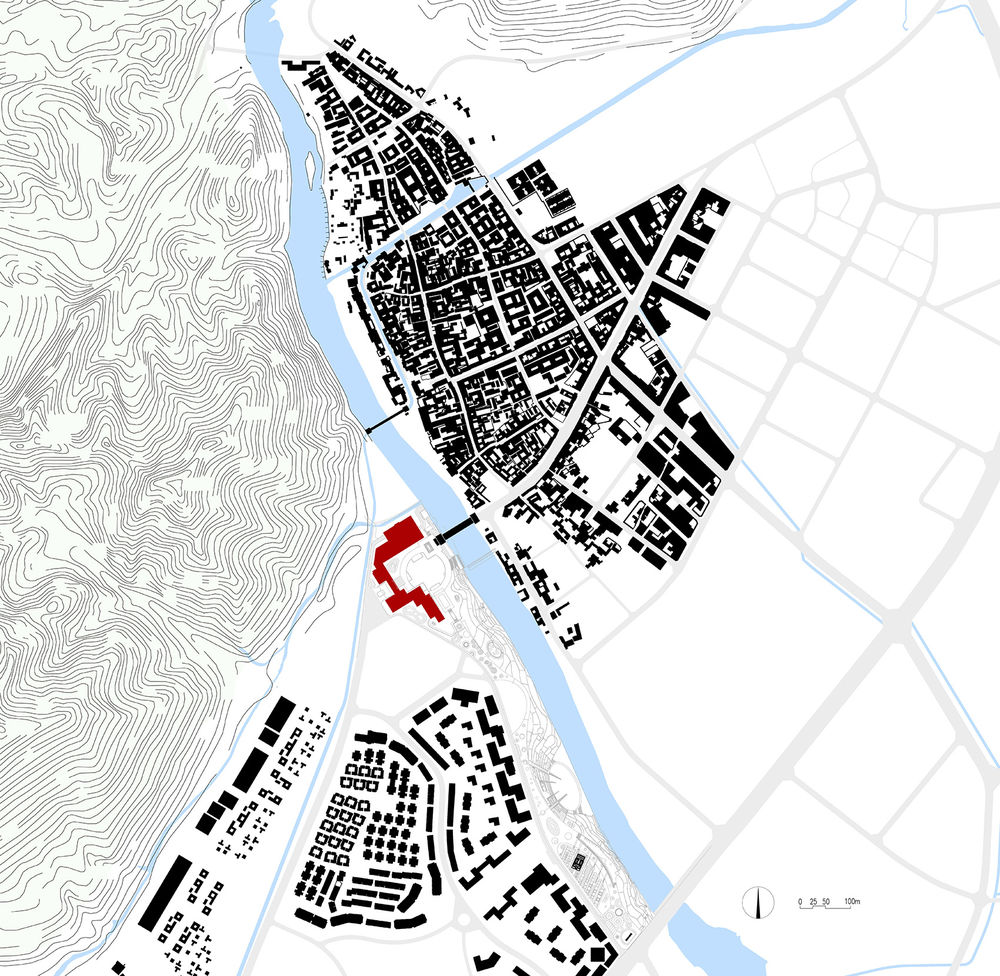
▼场地平面图,site plan
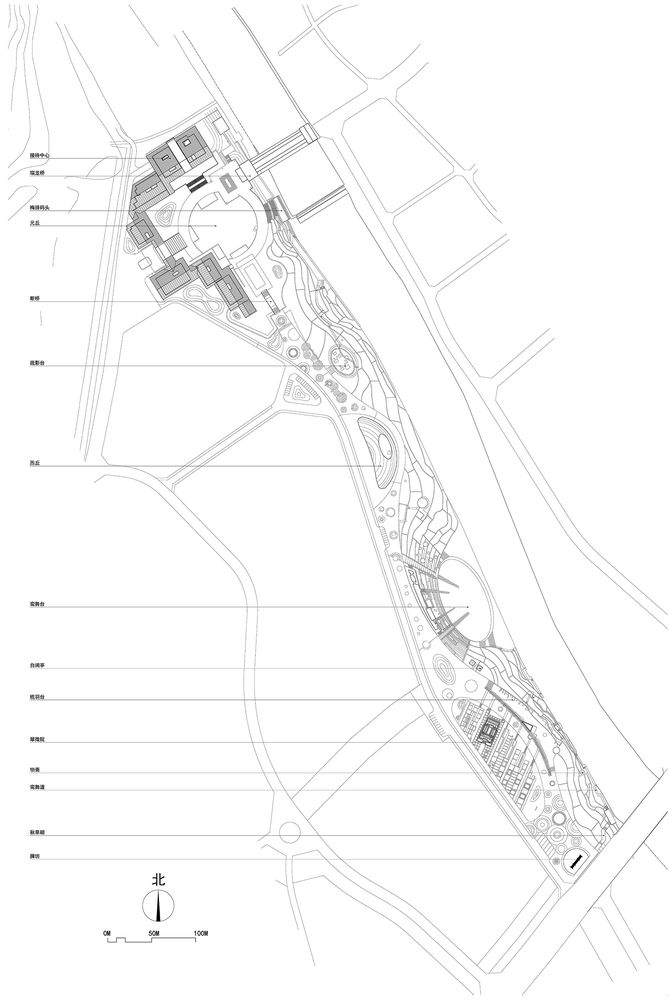
▼梅驿广场首层平面图,ground floor plan of Meiyi Square
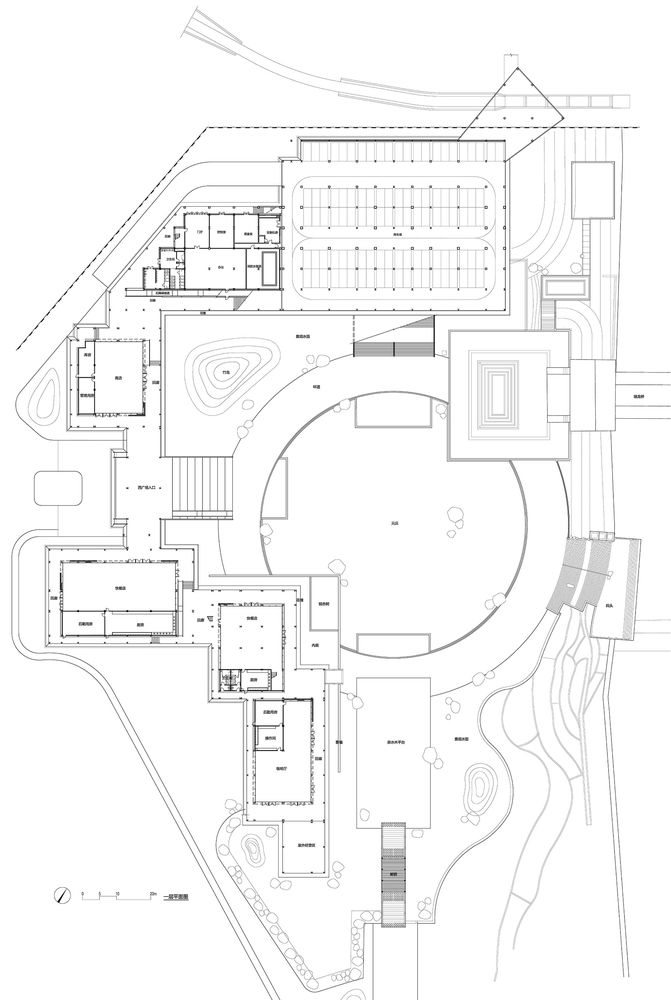
▼梅驿广场二层平面图,first floor plan of Meiyi Square
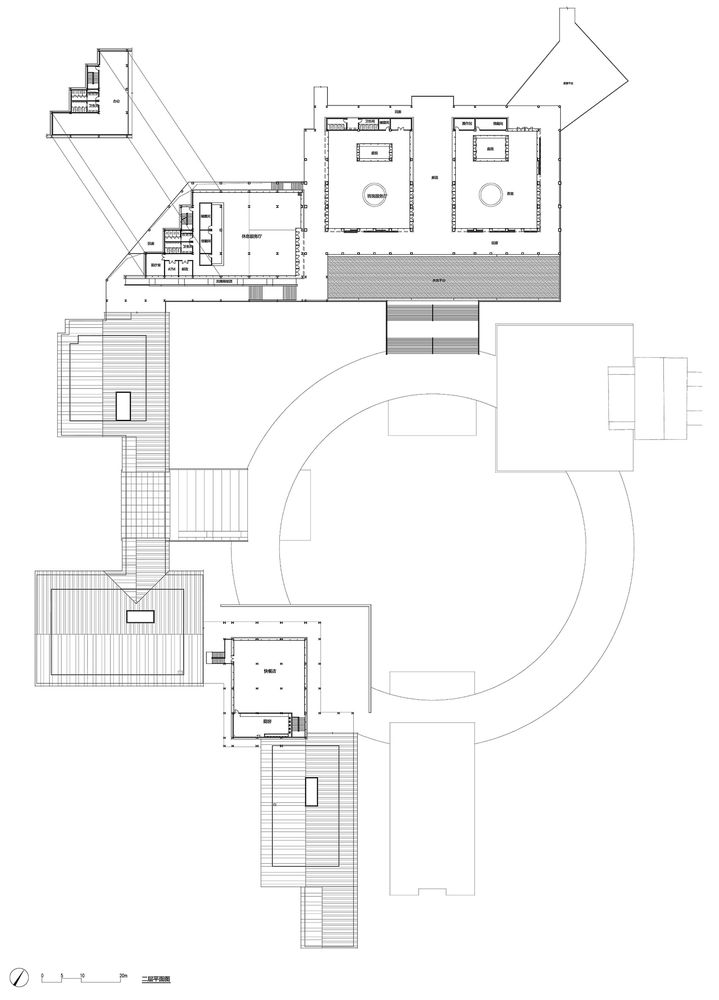
▼梅驿广场剖立面图,section and elevation of Meiyi Square


▼节点详图,structure detail
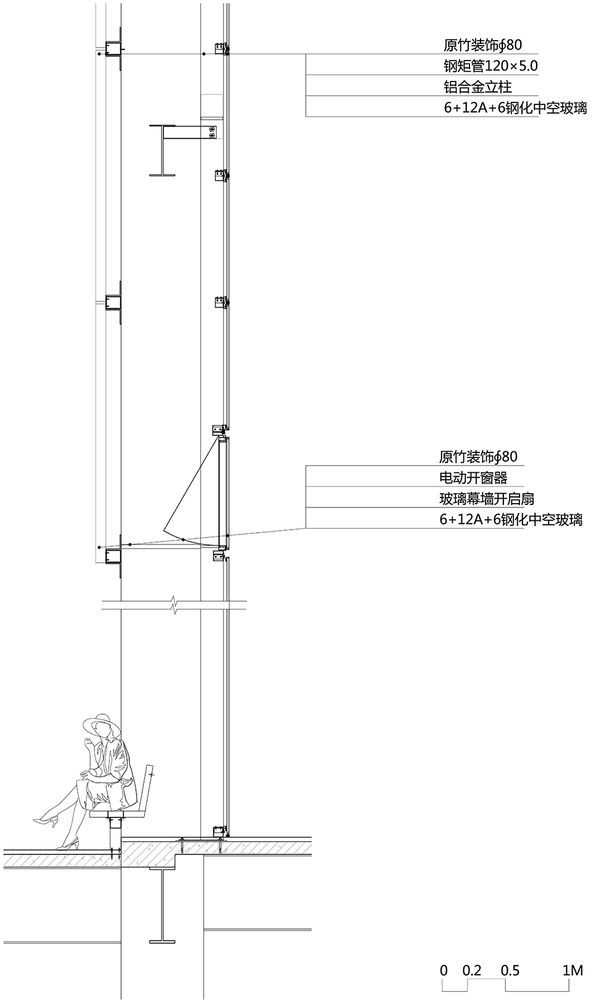
街子古镇梅驿广场和青鸾公园
设计单位:北京华清安地建筑设计有限公司成都分公司
主创建筑师: 蒲建聿
设计团队:刘伯英 蒲兵 吴沙沙
地点:崇州市街子镇
设计时间:2013~2014年
竣工时间:2014~2016年
基地面积:170亩
建筑面积:1.2万平米
结构形式:钢结构、钢筋混凝土框架结构
Jiezi Ancient Town Meiyi Square and Qingluan Park
Designed By: Beijing Huaqing An-design Architects Co., Ltd., Chengdu Branch
Lead Architects: Pu Jianyu
Design Team: Liu Boying, Pu Bing,Wu Shasha
Location: Jiezi Town, Chongzhou City
Time of Design: 2013-2014
Time of Completion: 2014-2016
Site Area: 170 acres
Construction Area: 12,000 square meters
Structure: steel structure, reinforced concrete frame structure

